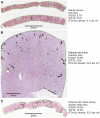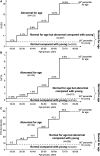Age-Based Versus Young-Adult Thresholds for Nephrosclerosis on Kidney Biopsy and Prognostic Implications for CKD
- PMID: 37254246
- PMCID: PMC10400104
- DOI: 10.1681/ASN.0000000000000171
Age-Based Versus Young-Adult Thresholds for Nephrosclerosis on Kidney Biopsy and Prognostic Implications for CKD
Abstract
Significance statement: Nephrosclerosis (glomerulosclerosis, interstitial fibrosis, and tubular atrophy) is the defining pathology of both kidney aging and CKD. Optimal thresholds for nephrosclerosis that identify persons with a progressive disease are unknown. This study determined a young-age threshold (18-29 years) and age-based 95th percentile thresholds for nephrosclerosis on the basis of morphometry of kidney biopsy sections from normotensive living kidney donors. These thresholds were 7.1-fold to 36-fold higher in older (70 years or older) versus younger (aged 18-29 years) normotensive donors. Age-based thresholds, but not young-age threshold, were prognostic for determining risk of progressive CKD among patients who underwent a radical nephrectomy or a for-cause native kidney biopsy, suggesting that age-based thresholds are more useful than a single young-age threshold for identifying CKD on biopsy.
Background: Nephrosclerosis, defined by globally sclerotic glomeruli (GSG) and interstitial fibrosis and tubular atrophy (IFTA), is a pathology of both kidney aging and CKD. A comparison of risk of progressive CKD using aged-based thresholds for nephrosclerosis versus a single young-adult threshold is needed.
Methods: We conducted morphometric analyses of kidney biopsy images for %GSG, %IFTA, and IFTA foci density among 3020 living kidney donors, 1363 patients with kidney tumor, and 314 patients with native kidney disease. Using normotensive donors, we defined young-age thresholds (18-29 years) and age-based (roughly by decade) 95th percentile thresholds. We compared age-adjusted risk of progressive CKD (kidney failure or 40% decline in eGFR) between nephrosclerosis that was "normal compared with young," "normal for age but abnormal compared with young," and "abnormal for age" in patients with tumor and patients with kidney disease.
Results: The 95th percentiles in the youngest group (18-29 years) to the oldest group (70 years or older) ranged from 1.7% to 16% for %GSG, 0.18% to 6.5% for %IFTA, and 8.2 to 59.3 per cm 2 for IFTA foci density. Risk of progressive CKD did not differ between persons with nephrosclerosis "normal compared with young" versus "normal for age but abnormal compared with young." Risk of progressive CKD was significantly higher with %GSG, %IFTA, or IFTA foci density that was abnormal versus normal for age in both cohorts.
Conclusions: Given that increased risk of progressive CKD occurs only when nephrosclerosis is abnormal for age, age-based thresholds for nephrosclerosis seem to be better than a single young-age threshold for identifying clinically relevant CKD.
Copyright © 2023 by the American Society of Nephrology.
Conflict of interest statement
L. Barisoni reports Consultancy: Protalix, Sangamo, and Vertex; Honoraria: Protalix, Sangamo, and Vertex; Advisory or Leadership Role:
Figures




References
-
- Improving Global Outcomes (KDIGO) CKD Work Group. KDIGO 2012 clinical practice guideline for the evaluation and management of chronic kidney disease. Kidney Int Suppl. 2013;3(1):1–150. doi:10.1038/kisup.2012.73 - DOI
Publication types
MeSH terms
Grants and funding
LinkOut - more resources
Full Text Sources
Medical
Research Materials
Miscellaneous

